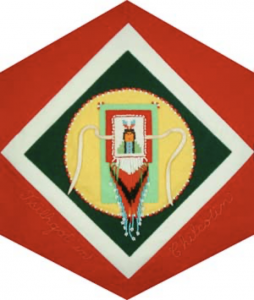Tsilhqot’in

The Block
Don Wise, Issues Co-ordinator for the Tsilhqot’in National Government, donated the square-shaped decoration filling the centre of this block. The piece features a colourfully beaded image of a Tsilhqot’in warrior and would typically be used to tie off the end of a braid. Tsilhqot’in’ people have deep respect for their warriors, who bravely fought outside forces to protect their homeland. The National Government’s emblem exemplifies this fervent pride with its powerful depiction of a warrior on horseback. He is silhouetted by the moon, around which clouds waft before settling into the shadowy shape of an eagle and mountainous landscape; his arms are raised to the sky in honour of the Earth. The image speaks volumes about the nature of the Tsilhqot’in people and captures their independent “never say die” spirit.
Cultural Profile
The Tsilhqot’in traditional territory, the Chilcotin-Cariboo plateau region, is one of the rooftops of the world, averaging an elevation of 1,300-1,600 metres. The six Tsilhqot’in bands, which prior to the smallpox epidemics of 1862 had a population of 30,000, today number 6,000. They still live off the land much as their ancestors have for centuries. Large and small game is hunted; the hides tanned and smoked by the women to make gloves, jackets and moccasins. The seasons still revolve around the salmon runs, despite the fact that the salmon population has drastically deminished. The tsilhqot’in harvest wild berries, such as huckleberries, blueberries, thimbleberries, raspberries and salmonberries. At one time berries would be dried and mixed with animal fat to make nutritious and well-preserved patties.
The collective memory of the Tsilhqot’in is marked by the War of 1864. In 1858 the cry of “Gold!” at Williams Creek sparked the beginning of the Cariboo Gold Rush. The Tsilhqot’in lifestyle and homeland would be forever altered by an influx of miners and adventurers who had little regard for Tsilhqot’in land title. Despite the difficulties of reaching the remote area, few could resist the allure of the region’s untamed beauty and the promise of untold wealth. By 1864, plans to build a road to transport supplies inland from the coast were underway.
During the fateful year of 1864, many warriors fought against an invasion by British colonial militia, and the period became a cataclysmic, defining moment for the nation. Six warriors, including war chief Lhats’as?in whose name means “we do not know who he is,” were captured, found guilty of murder and hanged. October 26th marks the annual Lhats’as?in(Klatsassin) Memorial Day, which celebrates the lives of those warriors and reminds the people that they are masters of their own destiny.
Sponsor: Carol White and her daughters Jana and Cheryl Comeau
